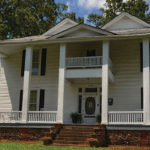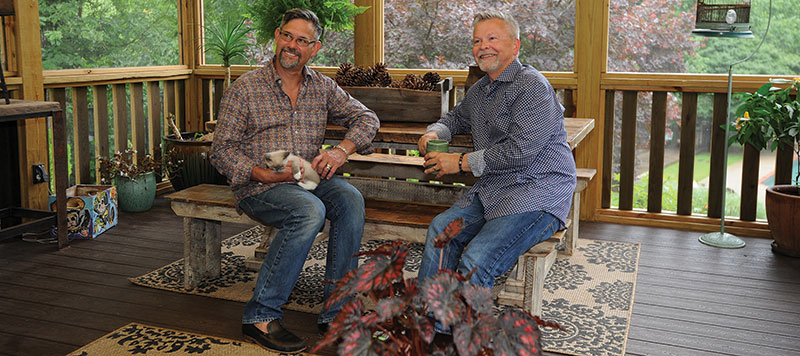
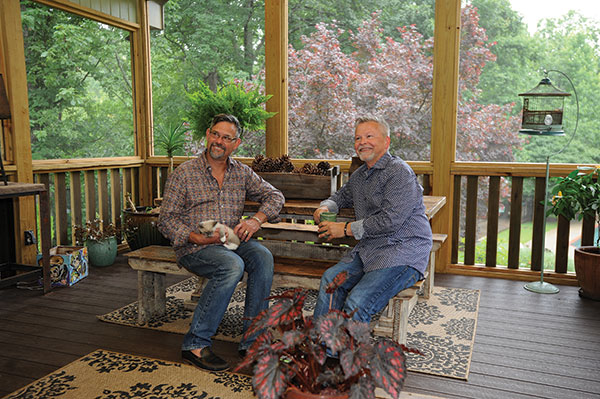
Reclaim, repurpose, reuse
Story by Elaine Hobson Miller
Photos by Wallace Bromberg Jr.
Rodney Tucker and Billy Connelly wanted a relaxing retreat, a place to get away from the hustle and bustle of downtown Birmingham and their high-pressure jobs at UAB Hospital. In all the years they have been together, they have never built something new, but always renovated. When an internet search turned up a small 1980s cabin at the end of its own cul-de-sac in Odenville a few years ago, they didn’t waste any time taking a look.
What they found was a 900-square-foot box with a wrap-around porch, a stick-built house masquerading as a cabin by hiding under log siding. What they saw was potential.
“It ended up being a total redo,” says Tucker. “Our contractor, James Wyatt (Wyatt Construction), took it down to the studs. We extended it a little bit and enclosed some areas of the porch.”
“Extended it a little bit” meant adding 700 square feet. Wyatt removed all but one interior wall, pushed a couple of outside walls a little further out, enclosed parts of the porch to create an entry hall at the front and a gallery at the back, and added a large, asymmetrical screened porch on one side. What was once a two-bedroom house with two tiny bathrooms now has a large master bedroom and two guest rooms, two large baths, a laundry room and the aforementioned gallery and entry hall. As for the log siding, he replaced that with a fiber cement siding.
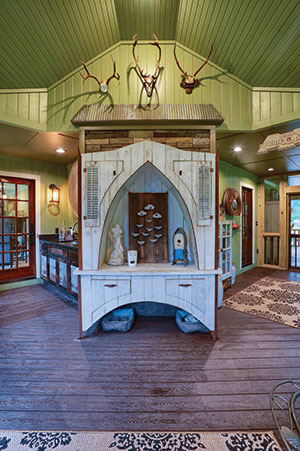
“Farmhouse chic” best describes the Tucker-Connelly house today. It’s filled with doors, furniture and decor fashioned from repurposed wood and metal. Most of the furniture was made by Stray Cats of Birmingham, while all the built-ins, such as the kitchen cabinets, were built by Joe Dickert of Big Rock Cabinets in Springville. Working with architect Bob Burns, Tucker, a palliative care physician, designed the “new” 1600-square-foot house (plus porches).
The section of the porch that formerly spanned the front of the house is now divided into anentryway with separate porches on either side. To the left and right of the entrance are the only two sections of the original porch that weren’t screened, glassed or incorporated into the house. On the left is the “cantina,” an outdoor overflow space for guests when the larger, asymmetrical screened porch gets crowded. The cantina is so named because its two tables have tops made from old tin Corona beer signs. A vintage, functional, circular Old Crown Beer thermometer hangs in the cantina area.
James Wyatt removed a wall to open up the living-dining area, turning it into one large room. The living room portion has a coffee table, credenza and end table made from reclaimed wood pallets. An Arthur Price oil painting of an old log cabin hangs on one of the walls.
“We replaced the dilapidated fireplace with Bessemer gray brick, and the new oak mantel is from an old mission-style house in Chattanooga,” Tucker says. “Only the leather sofa and love seat in here are new.”
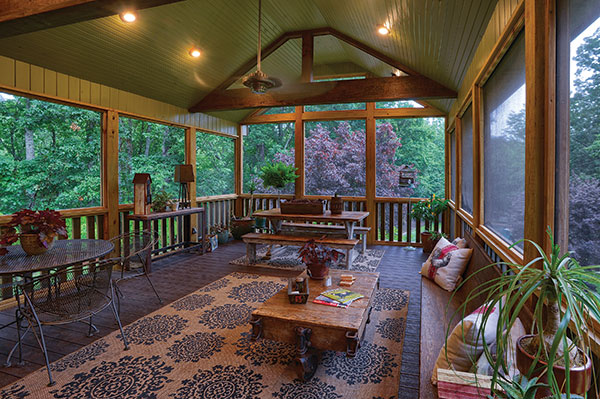
Stray Cats made the 3.5 x 8-foot kitchen island, topping it with zinc-coated stainless steel. The cabinets are a dark-stained oak, while the all-electric appliances include a double wall-oven, a glass stove top and a French-door refrigerator with four drawers. Tucker and Connelly chose quartz countertops because they look like marble. “We would have preferred marble, but it stains easily,” Connelly says.
Tucked into one end of the kitchen, opposite the refrigerator and ovens, is Tucker’s pride and joy: a bar. Its tin ceiling came from the roof of an old Victorian house in North Carolina, while its chandelier used to hang in Rodney’s parents’ house in Gadsden.
Underneath the countertop are a wine or beverage cooler and an ice maker. The shelves over the bar house Tucker’s collection of about 1,000 pieces of barware, including wine and cocktail glasses, cocktail and martini shakers. The etched ship decanters probably belonged to sea captains at one time. “We have enough shakers to allow each guest to make his own drink, if we weren’t concerned with breakage,” Tucker says.
On a narrow, inset wall between the bar and the living room is a vintage slot machine perched atop a church pedestal that looks like a pastor’s lectern. “Oh, the irony,” Tucker says.
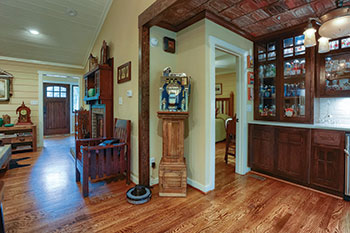
At the back of the house, behind the kitchen, is the gallery that Wyatt fashioned by enclosing that portion of the wrap-around porch. Tucker and Connelly refer to it as a gallery because that’s where much of their extensive pottery collection is housed. Displayed in a Dutch mission-style cabinet, it includes creamware and pieces by Weller and by Roseville.
A king headboard of repurposed bead-board dominates the master bedroom, but also notable are the side tables and a chest of drawers made of recycled tin ceiling tiles and a mission-style chair and desk. The banjo propped in one corner belonged to Tucker’s grandfather. That bathroom has new floor tiles that look like old, gray wood. The vanity is made of repurposed wood, too. The walls of the shower are a wider version of the bedroom’s floor tiles, while river rock covers the shower floor.
“We tried to keep everything neutral — earth tones — gray, brown, white beige — so the house would blend with its surroundings out here,” Tucker says. “We have some pops of sage green here and there, and the exterior walls are sage green, too. We wanted the house to be natural and complement the landscape. A modern glass and metal structure would be out of place here.”
On the opposite side of the living room and kitchen from the master suite, Wyatt restructured the original bedroom, bumped its wall out a bit and fashioned two smaller guest rooms, a short hallway to connect them, a large bathroom and a laundry room.
One guest room is dubbed The Hillbilly/Cowboy Room. There’s a large, predominantly red, pop-art, mixed-media piece of a vintage cowgirl on one wall, an equally colorful guitar in one corner, and a lamp that has a base of a moonshine jug with the moonshiner holding on for dear life (Mountain Boy Pottery out of Ohio).
Then, there is the collection of figurines — animals, hillbillies, outhouses, jugs, etc. — from the 1940s and ’50s in a nearby cabinet. Hanging rather incongruously in one corner because nothing else would fit there is a Catholic icon. The upper portion depicts Mary and Jesus, while a drop-down, hinged door beneath them would have been used for incense and candles in a good Catholic’s home.
The pack sled from Switzerland was used as the headboard for that room’s bed at one time, but now stands against a wall, next to a pair of wooden skis from Germany. The credenza and end table in that room were manufactured in Bali from wood reclaimed from boats. “Jamey (James Wyatt) bumped out one wall in here to make a window seat,” says Connelly, who is vice president of ambulatory services at The Kirklin Clinic of UAB Hospital. “This is where my mom often sits to quilt when she comes up.”
Down the hall, the bathroom doors once opened the entry to a surgery room at an old hospital in Decatur. “They were hospital green, but we sanded them down and applied wood sealer,” says Tucker. “Jamey spent a lot of time getting them to hang evenly and roll smoothly.” The vanity is one of the few manufactured pieces in the house, but Stray Cats made the mirror. The floor is the same type of tile as in the master bath, but in a different color. What appears to be a collection of small cigar-box covers on a board that’s covered with a wax sealer is the main art piece in this bath.
At the end of the short hall is another guest room made by enclosing another section of the wrap-around porch. “Jamie got creative and pushed out a section of the side wall to create a one-foot-by-ten-foot alcove that gives the room a little pizzazz,” Tucker says. To save space, Wyatt used pocket doors for the closet in this room. He enclosed another section of the wrap-around porch to create a laundry room off this bedroom.
The quilt on the bed here comes with an interesting background story. Tucker went to an estate sale and found old fabric squares that were newspaper backed, as if someone was preparing to piece a quilt. “One of the newspaper pieces dates to 1938,” Connelly says. “My mom finished the quilt in 2018.” More of the couple’s pottery collection is housed in an antique barber’s cabinet and a mission-style display cabinet.
When the couple throws a party, most guests end up on the large, asymmetrical porch on the left side of the house outside the kitchen-and-bar area. It’s such an inviting room that you just want to sit down and enjoy the breeze or soak up the woodsy atmosphere. Guests have a choice of seating here, including a pew from an old church in Selma that is gone now.
The repurposed theme is obvious in here, too. There’s a sofa table with a wood top made from flooring out of an old school in Georgia. The coffee table is actually a 1922 transfer table from a Boston manufacturing company.
One promontory of the porch features a white hutch made of repurposed wood out of North Carolina. Around the corner, an old Hudson hubcap that probably covered the spare tire on the back of that car hangs over feed-and-seed signs and a coat rack. It’s next to a white repurposed glass-front cabinet that was originally built into an old house. “I bought that cabinet at an antique store,” Tucker says. “I don’t like to refinish the vintage furniture we find. I sand them down and use a clear sealer.” Over that cabinet hangs a Hinman Milkers sign, while an old metal dairy box rests on top of the cabinet. The dairy box bears the name, “Connelly’s Dairy.”
“We bought that at an antique shop in Atlanta,” Tucker says. “In the early days of home milk delivery, the bottles would go into the metal box, and it would hang from a bicycle. I told Billy I didn’t know his family had a dairy.”
An unusual mirror hangs over the outdoor or porch sink that Connelly uses to wash the dogs and pot his house plants. It is a big dot inside a larger tin circle that was once part of a heater in a chicken house. Speaking of plants, this porch displays succulents, ferns, begonias, ponytail palm, a shrimp plant and not a few coleus.
Wyatt recalls saving only bits and pieces of the house’s original hardwood floors. “I think all we saved were pieces of the living room and master bedroom,” he says. “The kitchen was water damaged a little, had some rotten spots, so we put in a new subfloor there and new hardwood.”
Outside, the swimming pool required a total redo, too. “It had to be torn out and new gunnite poured,” Tucker says. “We also built a pool house that carries through with our unique decor as well.”
Landscaping is Connelly’s bailiwig, with the help of his mother, who visits about once a week. Cone flowers, zinnias, black-eyed Susans, petunias and salvia flank the rock-and-gravel walkway leading to the front door. Nearby are Knock Out roses, French and snowball hydrangeas, camellias, hostas and ferns. Japanese maples thrive throughout the property. “I’ve planted lots of fruit trees and muscadine arbors, lots of native azaleas,” Connelly says. “I’ve made jelly and wine from the muscadines. Gardening is my therapy.”
Exotic animals dot the landscape around the property, too. Four monkeys reside in two separate cages. Another cage houses Patagonian cavies and two kangaroos. A pasture features a zebra, emus, alpacas, horses, ostriches, sheep and goats. “I’ve always had exotic animals of some sort,” says Connelly. “Rodney tolerates them.”
“I love animals, too, but the volume we have is sometimes overwhelming,” Tucker confesses.
“You should see our feed bill,” Connelly adds.
Outdoor multi-level decks on one side of the driveway provide additional relaxation space. “They made this space usable,” Connelly says. “One of them replaced an outdoor dog pen, and another one camouflages the storm shelter under it.”
Security lights line the driveway, which winds past a derelict modular home used for storage, a barn, animal cages and the pasture, where the four-footed creatures are kept. And a fire hydrant.
“We have our own fire hydrant,” Tucker says. “It’s the result of the entire 30-acre property once being zoned for and promoted as a future housing development.”
Although the house renovations were completed about two years ago, the pair really aren’t finished with their retreat project. Ultimately, they would like to build a couple of small, one-room guest cottages.
“This was a large remodeling project, and we worked shoulder-to-shoulder on the design,” James Wyatt says. “I’ve done a lot of those in Mountain Brook and Vestavia, and it was good to do such a high-end remodel right here in St. Clair County.”











